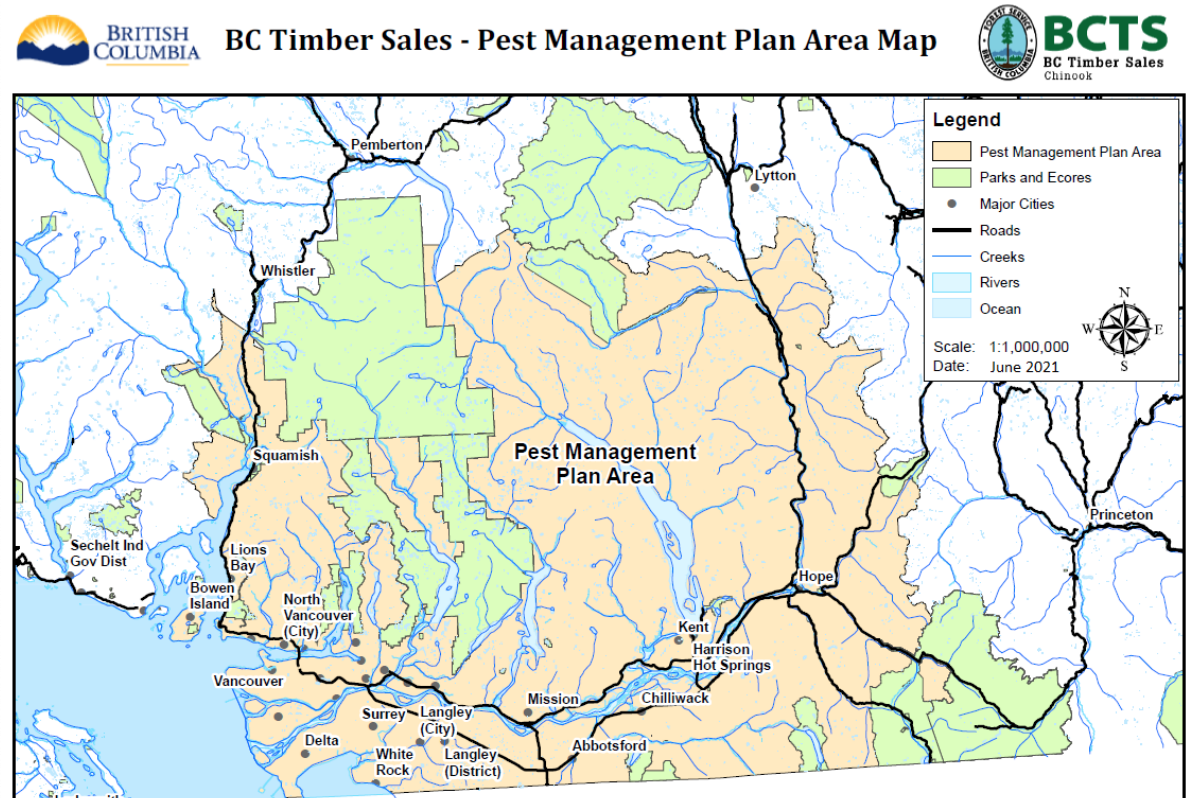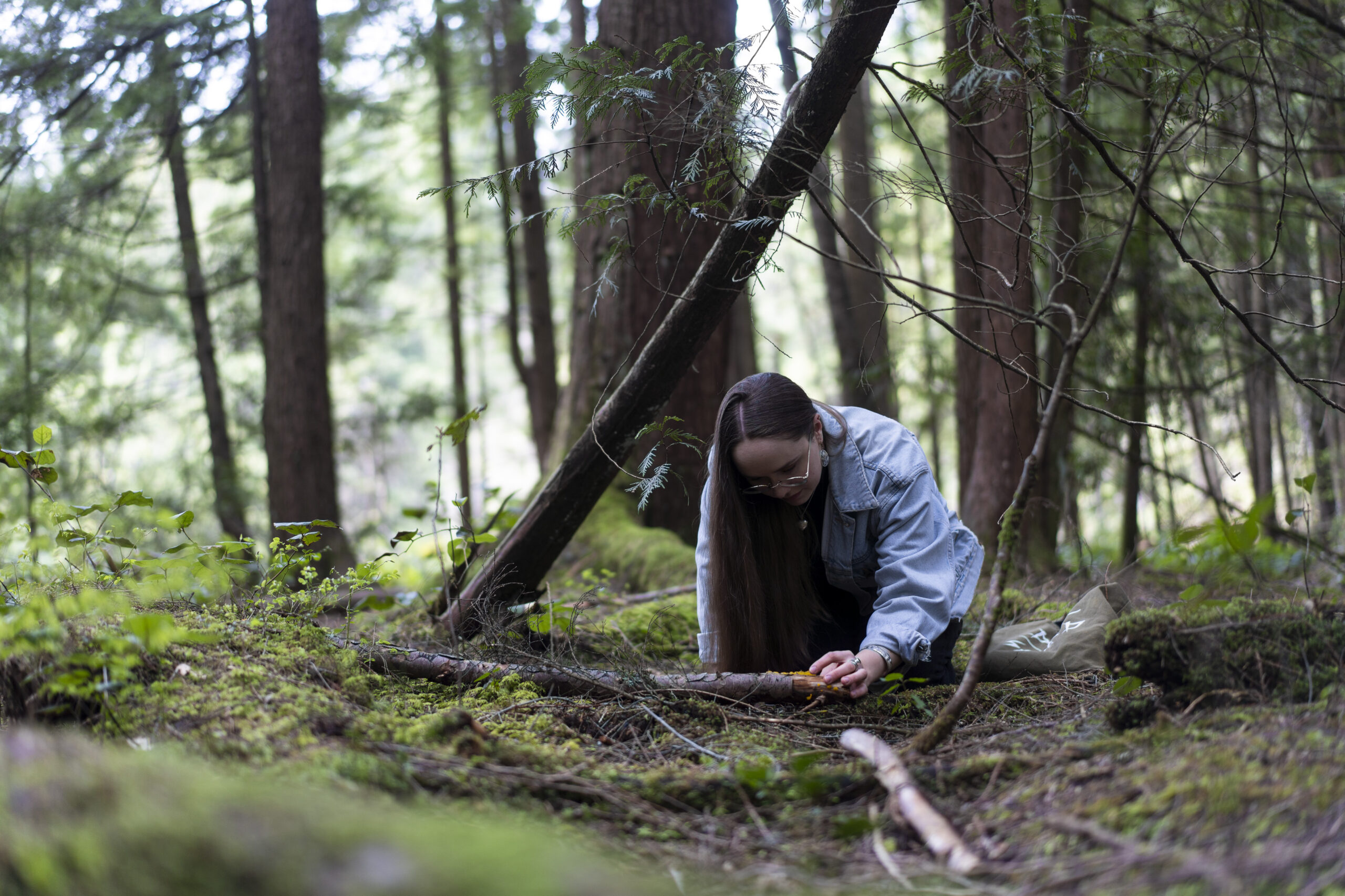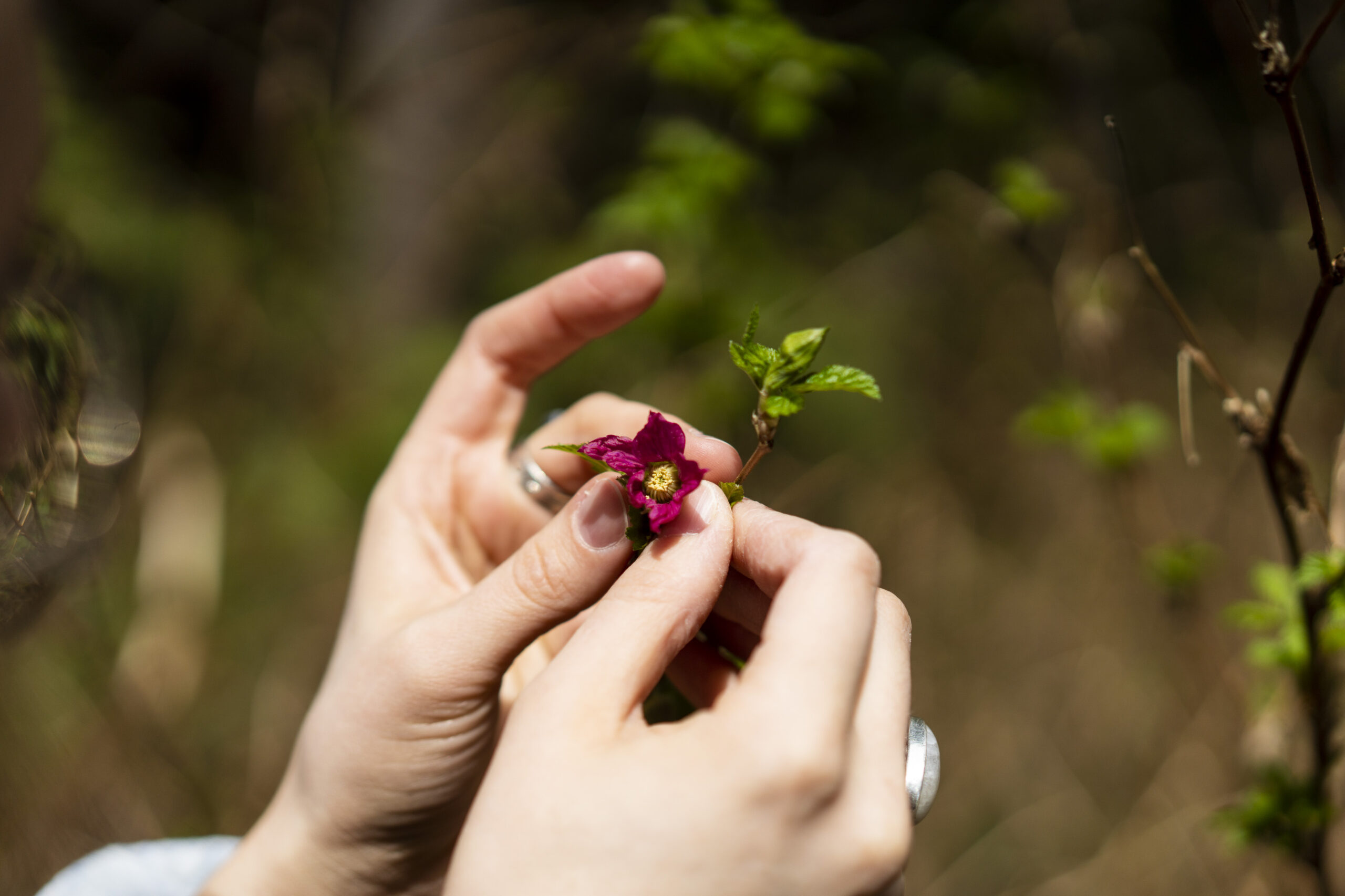
Celebrating 7 years of The Narwhal — and gearing up for the next 7
Between a fresh take on engagement and our new life on video, our team is...
When Angelina Hopkins Rose, an avid berry picker, found out she was pregnant in 2018, she and her husband set out to fill their freezer with traditional foods.
Ask any picker where to look for berries and they’ll tell you: “drive up a logging road and find a cut block and that’s where you’ll find huckleberries,” she said.
Since then, Hopkins Rose, who is St’át’imc on her dad’s side and Finnish on her mom’s, has learned that after a section of forest is logged, herbicides may be sprayed across the area to kill any plants that could thwart the growth of newly planted seedlings.
Thinking back to the berries she harvested before her son was born and wondering if some of them had been sprayed before is “terrifying,” she said.
To the industry, certain plants — salal, huckleberry, red alder and more — may be seen as pests impeding the growth of cash crops. But for Indigenous Peoples, they are traditional foods and medicines that have been relied upon for millennia.
In a recent proposal, BC Timber Sales, a government agency that manages about 20 per cent of the timber allowed to be cut each year, outlined a five-year pest management plan for its Chinook business area. It covers lands stretching from Squamish to Hope, affecting the territories of the St’át’imc, Stó:lō, Nlaka’pamux, Sḵwx̱wú7mesh and Tsleil-Waututh Nations.
The plan outlines various options for dealing with so-called pest species, from manually cutting the brush back to spraying glyphosate-based herbicides across a broad area from the air. The goal is to manage vegetation in a way that promotes the growth of planted seedlings that will one day be logged themselves.

When Hopkins Rose read through the document and saw the species BC Timber Sales considered to be pests, she was “livid.”
“Those are all my favourite berries,” she said. “And then, of course, I thought of the bears, the birds, all the animals” that also rely on these plants for sustenance.
In March, she started posting to Facebook and Instagram, calling for public consultation to be extended and urging people to help prevent the use of herbicides that could threaten plants harvested for food and medicine. The North Shore News, Vancouver Sun and Global News all published stories. And by early April, the BC Green Party alone said they had received some 2,000 emails from concerned constituents.
“The forests around Chilliwack are some of the most intensely sprayed forests in British Columbia, along with Prince George,” read a March 22 press release from the advocacy group Stop the Spray BC.
In the legislature on April 4, Forests Minister Katrine Conroy said, “since 2015, the use of glyphosate in the forestry sector has actually declined by 95 per cent.”
She said the chemical has not been used in the Sea to Sky region, one of the areas included in the proposed pest management plan, for more than a decade.
As of April 11, the proposed pest management plan at the centre of the controversy had not yet been submitted for approval to the Ministry of Environment and Climate Change Strategy, as is required, but it was expected soon, a spokesperson for the ministry said in a statement.
According to a statement from the Ministry of Forests, no herbicides will be sprayed in the area covered by the pest management plan this year if it is approved.
Glyphosate is the active ingredient in some of the most widely used herbicides around the world, including Roundup. In B.C., forestry companies use glyphosate to prevent other plants from outcompeting seedlings that have been planted to one day be cut and sold as timber.
In 2015, the World Health Organization determined that glyphosate is “probably carcinogenic to humans.” That determination is “based on ‘limited’ evidence of cancer in humans (from real-world exposures that actually occurred) and ‘sufficient’ evidence of cancer in experimental animals (from studies of ‘pure’ glyphosate).”
Currently, Health Canada considers the chemical to be “unlikely” to pose a cancer risk to humans. In a summary of its re-evaluation of glyphosate published in 2017, the department’s Pest Management Regulatory Agency noted that the World Health Organization’s determination is what’s called a hazard classification, meaning it didn’t consider the level of human exposure to glyphosate, which would determine the ultimate risk of developing cancer.
“Extensive research over decades by Health Canada confirm it is safe to use according to label specifications and this has provided the basis for the province’s legislative position on the use under very restrictive regulations,” a statement from the Ministry of Forests says.
“The province continues to monitor both use and research into the use of glyphosate.”
Bayer, which owns Roundup after purchasing Monsanto in 2018, has faced numerous lawsuits over claims the product causes cancer and in 2020 agreed to pay $10 billion to settle thousands of claims, according to the New York Times.
BC Timber Sales’ proposed pest management plan for the Chinook business area says aerial spray of herbicides may be used in situations where tree growth is impacted by competing vegetation in areas where there is “poor access, infrequent watercourses, low wildlife and fisheries values.”
The plan notes pesticide-free zones of 10 metres wide and buffer zones of five metres wide, which are meant to protect the area from any pesticide drifting, would be used to limit impacts on streams, lakes and wetlands during aerial spraying.
Once a pest management plan is approved, BC Timber Sales is required to consult with First Nations before submitting a notice of intent to treat. The notice of intent must include a map of the treatment location, an assessment of the site and information about the type of herbicide that will be used, a spokesperson for the Ministry of Forests said in a statement.
If the proposed pest management plan for the Chinook business area is approved, the spokesperson said there would also be further public consultation at the notice of intent to treat stage.
BC Timber Sales “has committed to a [notice of intent] consultation process of 90 days,” the spokesperson said.
But will the process be “more transparent and accessible to the general public and Indigenous people?” Hopkins Rose asked.
“Our whole issue was that this consultation process was inadequate,” she said.

Hopkins Rose told The Narwhal that despite repeated attempts to contact BC Timber Sales, she has not heard back from the agency. She did have a meeting with an official from B.C.’s Ministry Environment and Climate Change Strategy, which spoke about pest management plans in general, but according to Hopkins Rose they couldn’t comment on this specific plan because it hadn’t been submitted yet for the ministry’s approval.
James Steidle, the founder of Stop the Spray BC, said typically the detailed maps required at the notice of intent stage are not released to the public automatically. And even when he’s asked to see specific maps, he hasn’t been provided access.
Whether a proponent — either BC Timber Sales or a logging company — provides affected people or communities access to maps of proposed spraying areas is “entirely voluntary,” he said, pointing to section 10 of the province’s Integrated Pest Management Regulation.
The operative words, he said, are “if” and “offers.”
Hopkins Rose said the consultations BC Timber Sales has committed to should be widely advertised, not only in notices in local papers. She also said that detailed maps of proposed spraying areas should be posted online and easily accessible to the public.
The proponents and the government should also be clear about what would cause the cancellation of a planned spray. If there’s no ability to prevent a herbicide application, “then it’s not true consultation, it’s just notice,” she said.
She added that it’s important that Indigenous individuals are consulted, not just First Nations chiefs and councils.
“The people are the berry pickers, the medicine pickers, the mushroom pickers,” she said.
The Narwhal asked the Ministry of Forests for additional details about the notice of intent to treat consultation process and did not receive a response by publication time.
Lisa Wood, a plant biologist at the University of Northern British Columbia, has been studying the effect of glyphosate on plants in forested areas for almost a decade.
Her research focuses on what happens to plants that don’t receive a full dose when the herbicide is sprayed from the air.
While some may die, for those that don’t, glyphosate can persist in their tissues for years after the chemical has been applied, Wood’s research shows, although at steeply decreasing concentrations. The levels of glyphosate are below the concentrations that would be considered toxic for people, she said.

Wood has observed plants struggling a full year after the herbicide was sprayed.
“This vegetation that has survived doesn’t produce pollen to the same viability as it would normally, it doesn’t produce as much fruit or flowers. So the food within the ecosystem is reduced at that time period,” she said, forcing wildlife to search in other areas for food.
By the second year, she said, the ecosystem will start to recover, producing more fruits and flowers.
While Wood’s research has been primarily focused around Prince George, she said she would expect to see similar impacts over the short term in southern B.C. forests sprayed with glyphosate.
Different species will “have different methods of dealing with being attacked,” she said. Some will drop all their leaves attempting to rid themselves of the poison. Others turn yellow and as the glyphosate interrupts the photosynthetic process they become unable to produce food for themselves for a time.
Moving forward, Wood will be researching the ways in which glyphosate affects wildlife behaviour and movement.
It’s important to look at what’s happening across a broader landscape, Wood said.
Spraying in one cutblock might not have dramatic impacts, but if another nearby cutblock is sprayed the next year and another the year after that, the effects on the broader ecosystem can add up.
“We need to think about whether or not the use of glyphosate meets the needs of what we want our forests to be,” Wood said.
Ultimately, the question comes down to what the forests are valued for — timber resources or biodiverse ecosystems that are resilient to climate change.
Aspen trees, for instance, are one of the plants sometimes targeted by these pest management plans. But they are known to be resistant to wildfires and can serve as firebreaks, Steidle said.
Climate change is already leading to more frequent and intense wildfires in B.C. Just last year, thousands of people were forced to flee to safety as wildfires threatened their communities.
“Why would we be getting rid of any fire-resistant tree species on the landscape?” he asked.
The use of glyphosate to grow trees for timber is further evidence of the systemic and environmental racism that persists in B.C. policies, according to Green Party MLA Adam Olsen.
“I am deeply concerned that the government views food security only through a colonial lens and that being agriculture and food production in the western concept of it,” said Olsen.
“They’re killing a dozen different berries that have been collected and harvested and traded since time immemorial — incredibly important, staple food sources for Indigenous people.”
A member of the Tsartlip First Nation, Olsen said that in his own territory, “our beaches where we harvested clams are perpetually poisoned by runoff, by industrial agriculture and industry parks.”
Olsen raised his concerns with Conroy during question period on April 4, only a few days after the government celebrated the release of its action plan to implement the Declaration on the Rights of Indigenous Peoples Act. He asked if the forests minister believed “that the rights of Indigenous Peoples to harvest traditional plants are outweighed by the ministry’s interests to maximize harvest volumes by spraying glyphosate?”
In response, Conroy said all six First Nations affected by the pest management plan had been consulted and pointed to a statement from the Sḵwx̱wú7mesh Úxwumixw (Squamish Nation).
“They have agreed to the current plan. There will be no glyphosate use in that region,” she said.

In its April 1 statement, the Sḵwx̱wú7mesh Úxwumixw said it had “expressed concerns about the potential risks to the nation’s inherent rights to practice its culture, including the gathering of traditional medicines from forests” if the pest management plan was implemented.
The nation confirmed there were no plans to spray in the region and agreed to the pest management plan on the condition that BC Timber Sales must have written consent from Squamish Nation before any herbicides can be sprayed.
A spokesperson for the Ministry of Forests said in a statement that consultation with First Nations around the proposed pest management plan for the Chinook business area is ongoing.
“[BC Timber Sales] doesn’t consider government-to-government engagement with First Nations to ever be closed,” the statement said.
The Ministry of Forests told The Narwhal in a statement that BC Timber Sales has committed to a 90-day consultation after a notice of intent to treat is released. For Hopkins Rose and Steidle, that’s not good enough: they want the regulations changed to require transparent and fulsome consultation at all stages and in all regions of the province.
“In the long term, I would like to see them moving away from glyphosate,” Hopkins Rose said.
“In my language you say Tákem nsnek̓wnúk̓w7a, It means all my relations … and it reminds us we’re all connected.”
“You can’t just try to kill one part of the ecosystem and expect everything else to be healthy,” she said. “Biodiversity is essential for ecosystems.”
Get the inside scoop on The Narwhal’s environment and climate reporting by signing up for our free newsletter. On a warm September evening nearly 15...
Continue reading
Between a fresh take on engagement and our new life on video, our team is...

The public has a few days left to comment on Doug Ford’s omnibus development bill....

115 billion litres, 70 years to fix, $5.5 billion in lawsuits
